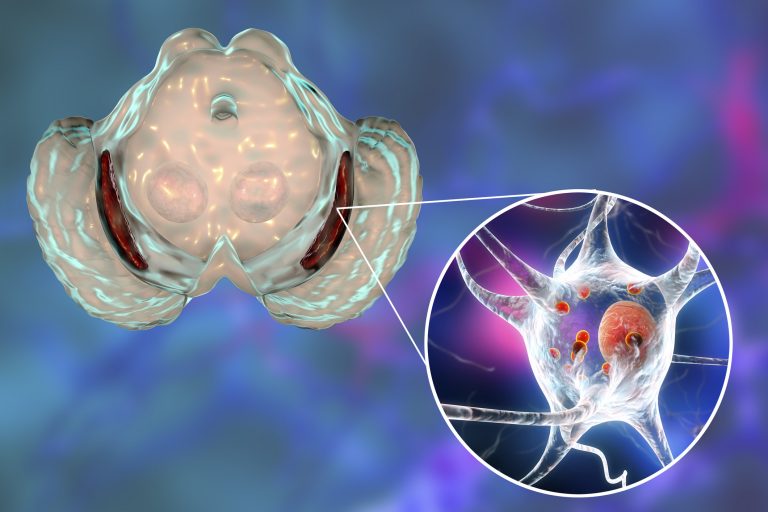
Researchers at The Scripps Research Institute have taken a novel approach to addressing the protein α-synuclein’s role in the development Parkinson’s disease. The protein, deemed undraggable due to its lack of binding pockets for small molecules, is known to aggregate Lewy bodies which culminate in the disease.
But the research team at Scripp’s embarked on a different approach. Rather than let α-synuclein be expressed, by which point it may become all but unmanageable, the Scripps Research scientists, together with colleagues from other institutions, decided to target the mRNA that encodes α-synuclein. Preventing mRNA from being processed by ribosomes, they discovered, is “cytoprotective.”
The scientists, led by Matthew D. Disney, Ph.D., professor, department of chemistry at Scripps, designed a small molecule that selectively targets the messenger RNA that encodes α-synuclein protein and selectively inhibits its translation. This small molecule, called synucleozid, stops the ribosome from detecting the messenger RNA template, thus preventing α-synuclein’s translation.
Details of this work appeared January 3 in the Proceedings of the National Academy of Sciences (PNAS), in an article titled, “Translation of the intrinsically disordered protein α-synuclein is inhibited by a small molecule targeting its structured mRNA.” The article’s authors suggest that their approach, the targeting of undruggable proteins at the level of their coding mRNAs, may slow the progression of Parkinson’s disease and related neurological disorders.
“Fortuitously, the … mRNA [that encodes] α-synuclein has a structured iron-responsive element (IRE) in its 5′ untranslated region (5′ UTR) that controls its translation,” the article’s authors wrote. “Using sequence-based design, we discovered small molecules that target the IRE structure and inhibit translation in cells, the most potent of which is named synucleozid. Both in vitro and cellular profiling studies showed synucleozid directly targets the α-synuclein mRNA 5′ UTR at the designed site.”
To enable this sort of lead identification work, Disney spent years building sequence-based design technologies. One of these technologies, Inforna, is described in the current study as follows: “Inforna is built around a database of experimentally determined, privileged RNA fold–small molecule interactions. That is, the interactions are both high-affinity and selective. Inforna then searches an RNA target for druggability, that is, whether it houses an RNA fold in the database. The small molecules that bind this targetable fold are lead chemical probes that can be assessed for biological effects.”
In other words, Inforna computationally uses genetic sequence to predict complementary small molecule-RNA interactions. This approach can sidestep the difficulties of targeting intrinsically disordered proteins.
The so-called druggable genome currently consists of only about 3,000 genes out of an estimated 20,000 protein-coding genes. Many undruggable proteins, Disney’s research suggests, are transcribed by RNA that do have stable structures, meaning the RNA should be druggable, offering an effective workaround.
“We are applying this across a number of disease indications, with our priority being applying these approaches to the diseases that have the most urgent medical need,” Disney said. Parkinson’s disease is clearly among them.
“The precise molecular mechanisms driving Parkinson’s disease remain to be fully elucidated,” noted M. Maral Mouradian, MD, director of the Institute for Neurological Therapeutics at Rutgers University and a co-author of the current study. “However, the amount of α-synuclein protein levels is an important factor in its pathologic misfolding and aggregation, initiating a cascade of events that lead to neuronal damage and Parkinson’s symptoms. Therefore, it stands to reason that reducing the amount of α-synuclein protein can mitigate this disease-causing cascade.”
“Identification of this α-synuclein messenger RNA-targeting probe,” he continued, “will enable us to evaluate the therapeutic value of reducing α-synuclein production in patients.” The benefit of choosing a small molecule to target mRNA rather than an RNA-binding oligonucleotide is that a therapeutic agent must be very, very small to cross the blood-brain barrier. It must also be selective, and apparently the starting compounds identified in the current study are selective.
“Proteome- and transcriptome-wide studies showed that the compound’s selectivity makes synucleozid suitable for further development,” the authors of the PNAS article reported. “Importantly, transcriptome-wide analysis of mRNAs that encode intrinsically disordered proteins revealed that each has structured regions that could be targeted with small molecules.”
Disney cautioned, however, that this is a proof-of-concept study, and that a long road lies ahead before synucleozid might become a Parkinson’s drug candidate that can move into clinical trials in humans.
“We are just at the beginning here, and there is much work to do,” Disney said. “We are showing that if you can inhibit a protein from being made, that may be advantageous over waiting to address its role in disease until after it is already made.”











